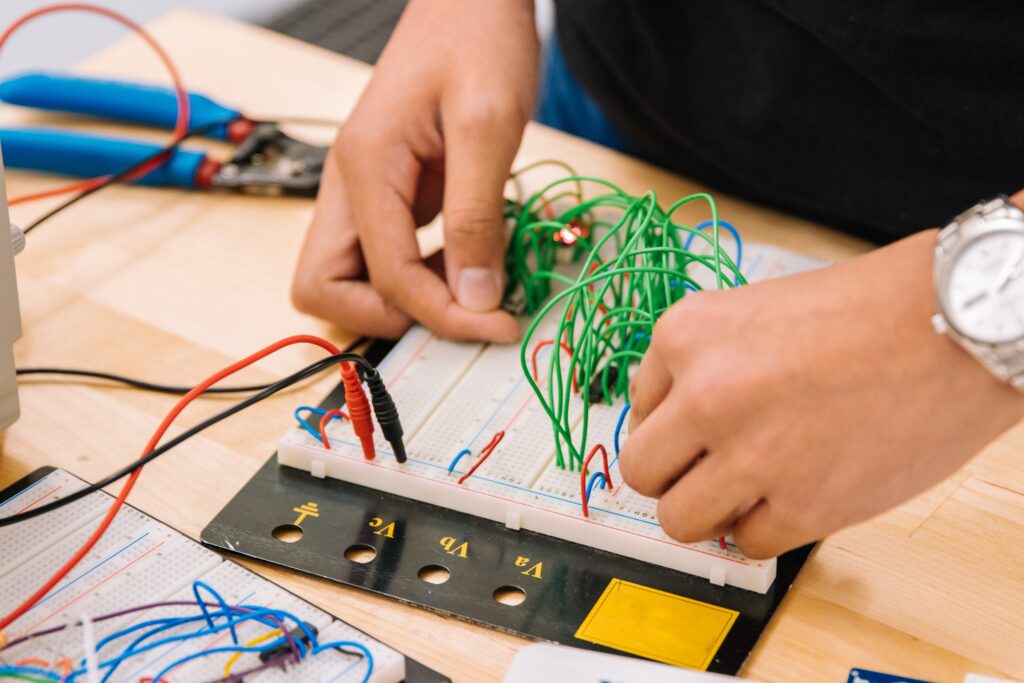Start your Python learning journey on the upGrad Blog, where you can access a wide range of programs, courses, and resources to enhance your skills. Whether you’re a beginner in MBA HR, Python, software development, or other fields, this platform offers project ideas and topics to help you get started. The blog also provides valuable information on job-oriented short-term courses, highest paying jobs in India, career options after B.Com, and final year project ideas. Explore trending posts on topics like the difference between lists and tuples, artificial intelligence salary in India, career options after BBA, and AWS salary in India. Take advantage of the free courses available on subjects like marketing, data science, machine learning, management, technology, career planning, law, and soft skills. Additionally, the upGrad Blog offers valuable resources for studying in the USA and Canada, as well as opportunities for 1-on-1 career counseling. Let’s delve into the exciting world of codes and start your Python learning journey with upGrad.

Getting Started with Python
Introduction to Python
Python is a high-level programming language that is widely used in various fields such as data analysis, web development, artificial intelligence, and scientific computing. It is known for its simplicity and readability, which makes it an excellent language for beginners to learn and professionals to work with. Python is an interpreted language, meaning that you can write and run your code without the need for a separate compilation step. This article will guide you through the fundamentals of Python programming and help you get started on your journey to becoming proficient in Python.
Why Learn Python?
There are several reasons why learning Python is beneficial. Firstly, Python has a clean and easy-to-understand syntax, making it easier to learn and read compared to other programming languages. This makes it a great language for beginners who are just starting their programming journey. Secondly, Python has a vast and active community, which means that there are plenty of resources and support available for learners. Whether you have a question, need help with a problem, or want to collaborate on a project, you can easily find assistance within the Python community. Additionally, Python has a wide range of libraries and packages that make it a powerful tool for various applications, including data analysis, machine learning, web development, and more. Learning Python opens up numerous career opportunities in these fields and gives you a competitive edge in the job market.
Setting up Python on Your Computer
Before you can start writing and running Python code, you need to set up Python on your computer. The first step is to download and install Python from the official Python website (https://www.python.org/). Python is available for Windows, macOS, and Linux, so you can choose the version that is compatible with your operating system. Once you have installed Python, you can open the command prompt or terminal and type “python” to check if the installation was successful. If Python is installed correctly, you will see the Python version and a prompt where you can start writing your code. Additionally, you can set up a development environment or integrated development environment (IDE) to make your coding experience more efficient and productive.
Choosing an IDE
An IDE is a software application that provides comprehensive tools and features to help developers write, debug, and test their code. There are several IDEs available for Python, and the choice ultimately depends on your personal preference and requirements. One popular IDE for Python is PyCharm, which is developed by JetBrains. PyCharm offers a wide range of features, including intelligent code completion, code inspections, refactoring tools, and debugging capabilities. Another popular option is Visual Studio Code, which is a lightweight and extensible IDE that supports Python through various extensions. Other notable IDEs for Python include Anaconda, Jupyter Notebook, and Spyder. It is recommended to try out multiple IDEs and determine which one suits your needs the best.
Python Basics
Syntax
The syntax of a programming language refers to the set of rules that dictate how the code should be written and structured. Python has a simple and clean syntax that emphasizes readability. Indentation is crucial in Python and is used to indicate blocks of code. Instead of using curly braces or keywords like “end” to denote the end of a block, Python uses consistent indentation to achieve this. For example, in a loop or function definition, the indented lines of code are considered part of the block. This indentation-based syntax makes Python code more organized and easier to understand.
Variables
In Python, variables are used to store values that can be accessed and manipulated throughout the program. Unlike some other programming languages, Python does not require you to explicitly declare the data type of a variable. You can simply assign a value to a variable, and Python will infer the data type based on the assigned value. Variable names in Python should be descriptive and follow certain naming conventions. It is common to use lowercase letters and underscores to separate words in variable names, such as “my_variable” or “student_age”.
Data Types
Python supports a variety of data types, including integers, floating-point numbers, strings, booleans, lists, tuples, sets, and dictionaries. Integers represent whole numbers, while floating-point numbers represent decimal numbers. Strings are sequences of characters enclosed in single or double quotes. Booleans can have two values, True or False, and are often used in logical operations. Lists are ordered collections of items, tuples are immutable sequences, sets are unordered collections of unique elements, and dictionaries are key-value pairs.
Operators
Operators in Python are symbols or keywords that perform various operations on operands. Python includes arithmetic operators (such as +, -, *, /), comparison operators (such as ==, !=, >, <), logical operators (such as="," and, or, not), assignment +="," -=")," and more. these allow you to perform mathematical calculations, compare values, combine conditions, assign values variables, among other operations.< />>
Control Flow
Control flow refers to the order in which statements are executed in a program. Python provides several control flow statements, including if-else statements, for loops, while loops, and break and continue statements. If-else statements allow you to execute specific blocks of code based on certain conditions. For loops iterate over a sequence or collection of items, executing a block of code for each item. While loops repeatedly execute a block of code as long as a certain condition is true. Break and continue statements allow you to alter the flow of a loop by either exiting the loop entirely or skipping the remaining code and moving to the next iteration.
Data Structures
Lists
Lists are one of the most versatile data structures in Python. They are ordered collections of items, enclosed in square brackets and separated by commas. Lists can contain elements of different data types and can be modified, meaning you can add, remove, and update items in a list. You can access individual elements of a list using their index, which starts from 0. Lists support various operations and methods, such as slicing, concatenation, sorting, and searching.
Tuples
Tuples are similar to lists in that they are ordered collections of items. However, tuples are immutable, meaning that once created, their elements cannot be modified. Tuples are enclosed in parentheses and separated by commas. They are commonly used to store related pieces of data together. Tuples support indexing and slicing, allowing you to access specific elements or subsets of a tuple.
Sets
Sets are unordered collections of unique elements. They are enclosed in curly braces or can be created using the “set()” function. Sets do not allow duplicate values, so they are often used to remove duplicates from a list or perform mathematical set operations such as union, intersection, and difference. Sets can also be modified, allowing you to add or remove elements.
Dictionaries
Dictionaries are key-value pairs, where each key is associated with a value. They are enclosed in curly braces and consist of comma-separated key-value pairs, where the key and value are separated by a colon. Dictionaries are unordered, meaning that the order in which the key-value pairs are stored may not be preserved. You can access the value associated with a specific key by using the key as an index. Dictionaries are commonly used to store and retrieve data in a structured manner.
Functions
Defining Functions
Functions are blocks of reusable code that perform a specific task. They allow you to break down large programs into smaller, more manageable pieces. In Python, you can define a function using the “def” keyword, followed by the function name, parentheses for optional parameters, and a colon. The function body is indented and contains the code that is executed when the function is called. Functions can have optional parameters, which allow you to pass values to the function when calling it.
Parameters and Arguments
Parameters are variables defined in the function declaration that receive values when the function is called. Arguments, on the other hand, are the actual values that are passed to a function when calling it. Parameters and arguments allow you to pass data to a function, making it more flexible and reusable. Python supports both positional arguments, where the order of the arguments matters, and keyword arguments, where the arguments are identified by their associated parameter names.
Returning Values
Functions can return values, which allow them to provide a result or output to the caller. In Python, you can use the “return” keyword followed by the value or expression that you want to return from the function. A function can have multiple return statements, but once a return statement is executed, the function immediately exits and returns the specified value. If a function does not have a return statement, it is considered to return None by default.
Lambda Functions
Lambda functions, also known as anonymous functions, are small, inline functions that do not have a name. They are defined using the “lambda” keyword, followed by the function parameters and a colon, and the expression or statement to be executed. Lambda functions are often used when a function is needed for a short duration or when a function is required as an argument to another function. They are particularly useful in functional programming and when working with higher-order functions.

Modules and Packages
Importing Modules
Modules in Python are files that contain reusable code, such as functions, classes, and variables. You can import modules into your program using the “import” keyword, followed by the module name. Once imported, you can access the functions, classes, and variables defined in the module using dot notation. Python has a vast standard library that provides modules for various purposes, such as math, random, datetime, and more. Additionally, you can create your own modules and import them into your programs.
Creating Modules
Creating modules in Python allows you to organize your code into separate files and promote code reusability. To create a module, you need to define functions, classes, or variables in a file with a .py extension. The module file can then be imported and used in other programs. It is recommended to group related functions and classes together in a module to make it more modular and maintainable. Modules can also contain a special variable called “name“, which indicates the name of the module when it is being executed.
Working with Packages
Packages are a way of organizing related modules into a hierarchical directory structure. A package is essentially a directory that contains multiple module files and an additional file called “init.py”. The “init.py” file is executed when the package is imported and can contain initialization code for the package. To import modules from a package, you need to specify the package name followed by the module name, separated by dots. Packages allow you to create a modular and organized codebase, especially for larger projects.
File Handling
Reading and Writing Files
File handling is an essential aspect of programming, as it allows you to interact with files on your computer. Python provides built-in functions for reading and writing files. To open a file for reading or writing, you can use the “open()” function, which takes the file path and the mode as parameters. The mode can be “r” for reading, “w” for writing, “a” for appending, and more. When reading a file, you can use the “read()” function to read the entire contents of the file or the “readline()” function to read one line at a time. When writing to a file, you can use the “write()” function to write data to the file.
Working with CSV Files
CSV (Comma-Separated Values) files are a common file format used for storing tabular data. Python provides a module called “csv” that allows you to read from and write to CSV files. To read from a CSV file, you can use the “reader()” function from the “csv” module, which returns a reader object that can be iterated over to access the rows of the CSV file. To write to a CSV file, you can use the “writer()” function from the “csv” module, which creates a writer object that allows you to write rows to the CSV file.
Working with JSON Files
JSON (JavaScript Object Notation) is a popular data interchange format that is used for storing and transmitting data. Python provides a module called “json” that allows you to work with JSON files. To read from a JSON file, you can use the “load()” function from the “json” module, which loads the contents of the JSON file and returns a Python object. To write to a JSON file, you can use the “dump()” function from the “json” module, which takes a Python object and writes it to a JSON file.

Object-Oriented Programming (OOP)
Classes and Objects
Object-oriented programming (OOP) is a programming paradigm that organizes data and code into objects. A class is a blueprint for creating objects, which defines the properties (attributes) and behaviors (methods) that the objects will have. Objects are instances of a class, and each object has its own unique set of attribute values. In Python, you can define a class using the “class” keyword, followed by the class name and a colon. The class body contains the definitions of the attributes and methods of the class. You can create objects from a class using the class name followed by parentheses.
Inheritance
Inheritance is a fundamental concept in OOP that allows you to create new classes based on existing classes. The new class, called the derived class or subclass, inherits the attributes and methods of the existing class, called the base class or superclass. In Python, you can define a subclass by specifying the base class in parentheses after the subclass name. The subclass can then access and override the attributes and methods of the base class. Inheritance promotes code reuse and allows you to create hierarchies of related classes.
Encapsulation
Encapsulation is the practice of bundling data and the methods that operate on that data into a single unit called an object. Encapsulation provides a way to hide the internal details of an object and only expose a public interface. In Python, you can achieve encapsulation by using the concept of visibility modifiers. By default, all attributes and methods of a class are public, meaning that they can be accessed from outside the class. You can use the underscore (_) convention to indicate that an attribute or method is intended for internal use only.
Polymorphism
Polymorphism is the ability of an object to take on different forms or exhibit different behaviors depending on the context. In OOP, polymorphism allows objects of different classes to be treated as objects of a common superclass. This enables you to write code that can work with objects of different types without needing to know the specific type at compile time. In Python, polymorphism is achieved through method overriding and method overloading. Method overriding allows a subclass to provide a different implementation of a method that is already defined in the base class. Method overloading allows multiple methods with the same name but different parameters to be defined in a class.
Exception Handling
Understanding Exceptions
Exceptions are events that occur during the execution of a program that disrupts the normal flow of the program. They can be caused by various factors, such as invalid input, file errors, network errors, and more. When an exception occurs, Python raises an exception object, which contains information about the type of exception and the location where it occurred. Understanding exceptions and how they are raised can help you identify and handle errors in your code effectively.
Using Try-Except Blocks
Try-except blocks in Python allow you to catch and handle exceptions. By using a try-except block, you can specify the code that you want to monitor for exceptions and the actions to take if an exception occurs. The try block contains the code that may raise an exception, while the except block contains the code that is executed if an exception is raised. You can catch specific types of exceptions by specifying the exception type in the except block, or you can catch multiple exceptions by specifying a tuple of exception types.
Handling Multiple Exceptions
In some cases, you may want to handle multiple exceptions in the same way. Python allows you to catch multiple exceptions in a single except block by separating the exception types with commas. This allows you to consolidate the exception handling code and reduces code duplication. Additionally, you can use a catch-all except block to handle any exception that is not caught by the previous except blocks. However, it is important to use catch-all except blocks sparingly, as they can make it difficult to identify and debug specific exceptions.
Working with Libraries and APIs
Installing External Libraries
Python has a vast ecosystem of third-party libraries that provide additional functionality and extend the capabilities of Python. To use these external libraries in your programs, you need to install them first. Python provides a package manager called pip, which allows you to easily install, upgrade, and manage external libraries. To install a library using pip, you can use the command “pip install library_name” in the command prompt or terminal. Once installed, you can import the library into your program and use its functions and classes.
Using APIs with Python
APIs (Application Programming Interfaces) allow different software systems and applications to communicate and interact with each other. Python provides various libraries and frameworks for working with APIs, such as requests, urllib, and aiohttp. These libraries allow you to send HTTP requests, handle RESTful APIs, parse JSON responses, and more. APIs provide a way to connect your Python programs to external services, retrieve data, and perform actions programmatically.
Examples of Using Popular Libraries
Python has a wide range of popular libraries that are widely used in various domains. Some examples of popular Python libraries include NumPy for scientific computing, Pandas for data manipulation and analysis, Matplotlib for data visualization, Flask for web development, TensorFlow for machine learning, and Django for building web applications. These libraries provide powerful functionalities and make it easier to accomplish complex tasks in Python. Learning how to use these libraries can significantly enhance your productivity and enable you to work on advanced projects.
Advanced Python Concepts
Decorators
Decorators are a powerful feature in Python that allow you to modify the behavior of functions or classes without modifying their source code. Decorators are defined using the “@” symbol followed by the decorator function name, which is then placed on top of the function or class that you want to modify. Decorators can be used for various purposes, such as adding logging or timing functionality to functions, applying validation or authorization to functions, and more. Decorators are a key component of metaprogramming in Python and enable code reusability and modularity.
Generators
Generators are a special type of function in Python that allows you to create iterators. Iterators are objects that can be iterated over, such as lists or strings. Generators are defined using the “yield” keyword, which allows you to generate a sequence of values one at a time. When a generator function is called, it returns a generator object, which can then be iterated over using a for loop or the “next()” function. Generators are memory-efficient, as they do not store the entire sequence of values in memory. Instead, they generate each value on the fly, saving memory resources.
Multithreading
Multithreading is a technique in Python that allows multiple threads to execute concurrently within a single program. Threads are lightweight and independent units of execution that share the same memory space. Python provides a “threading” module that allows you to create and manage threads. Multithreading can be useful when you have tasks that can be executed concurrently, such as fetching data from multiple sources or performing parallel computations. However, it is important to be cautious when working with threads, as they can introduce race conditions and synchronization issues.
Regular Expressions
Regular expressions, also known as regex, are powerful patterns used to match and manipulate strings. In Python, the “re” module provides support for regular expressions. Regular expressions consist of a combination of characters and special symbols that represent patterns. You can use regular expressions to search strings for specific patterns, extract data from strings, validate input, and perform text manipulation tasks. Regular expressions can be complex and may require some practice to master, but they are a valuable tool for working with textual data.
Database Connection
Python provides libraries and modules for connecting to databases and performing database operations. One popular library for database connectivity in Python is “sqlite3”, which allows you to work with SQLite databases. Additionally, there are libraries available for connecting to other database systems, such as MySQL, PostgreSQL, MongoDB, and more. These libraries provide APIs for executing SQL queries, inserting and retrieving data, and managing database connections. Connecting Python to a database opens up opportunities for storing and retrieving data, building applications with persistent storage, and working with large datasets.
In conclusion, Python is a versatile and powerful programming language that is widely used for various applications. Whether you are a beginner or an experienced programmer, learning Python can open up numerous career opportunities and enhance your problem-solving skills. By understanding the basics of Python, such as syntax, variables, and data types, and diving into more advanced concepts like object-oriented programming, exception handling, and working with external libraries and APIs, you can become proficient in Python and leverage its capabilities to build innovative solutions. Additionally, the Python ecosystem offers a vast range of resources, libraries, and frameworks that can assist you in your programming journey. So, get started with Python today and embark on a rewarding learning experience.

